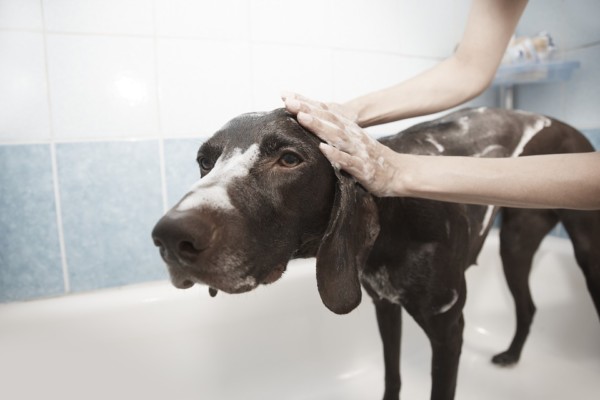If you’ve owned a dog or ever worked with dogs, you probably already know that allergic reactions in dogs can be a serious concern (so much so that there are even foods that you should never feed to a dog). Even when they aren’t lethal, however, allergies can still pose a major headache for both dog and owner. That’s why it’s important to be able to recognize the signs of allergies and know what to do in order to provide your pooch with some relief.
Food Allergies v. Environmental Allergies
The general symptoms for allergies in dogs are very similar to those you’d find in humans. Itchiness, sneezing, swelling, and other common signs will manifest for both food and environmental allergies, making distinguishing between the two difficult. It’s still possible to differentiate, however, and the making that distinction matters.
Food allergies can take years to develop, according to PetMD, and as a result are not often first on many pet owners minds when they notice symptoms in their pets. The location of certain skin problems can be indicative of food-related sensitivities, however:
“If you notice lesions all over your dog’s body, on the flanks, ribs, hips or knees there’s a big chance it’s a food allergy.”
As for environmental allergies, these will often manifest seasonally, giving dog owners a pattern of symptom appearance to clue in on. Unfortunately, in instances where environmental allergies become year-round, it will take some trial-and-error to pinpoint the causes and treat the symptoms.
Allergy Treatment Options for Your Dog
With the source of your dog’s allergies narrowed down, you can work with a veterinarian to start controlling them. In the case of food allergies, the plan of attack is to review your dog’s dietary history, then eliminating the offending ingredients. Many vets will suggest swapping out common protein sources (chicken, pork, beef, etc.), for protein sources your dog may not have been exposed to yet (lamb, fish, duck, etc.) to avoid further allergic reactions.
It can take months of consistency for specialized diets to show results, though, so it’s important to for you to follow your vet’s instructions to the letter. In the best cases, your dog’s food allergies will subside, and you can slowly add other foods back into their diet.
When it comes to environmental allergies, the method of relief will depend on the specific allergen causing your dog’s symptoms. Antihistamines, for instance, can provide your dog the same kind of control over itching and sneezing as they would humans. In other cases, supplements like omega-3 fatty acids, coconut oil, quercetin, bromelain, papain, and fish oils can help reduce allergy-related inflammation, joint pain, and the like.
Regardless, though, taking control of your dog’s environment and other simple, preventative measures can often go furthest when trying to get your dog’s seasonal allergies under control. Whenever possible, prevent your dog from coming into contact from the irritants that spark their allergic reactions. Wipe down their feet after a walk, or start using dog-boots to keep their paws away from potential allergens.
A good old-fashioned bath goes a long way in keeping dog’s safe from allergens as well. If you’re a business owner who wants to provide a benefit to dogs while simultaneously attracting more customers, contact us to learn more about adding an Evolution Dog Wash to your business (along with the many associated benefits for businesses, pet owners, and pets alike).



